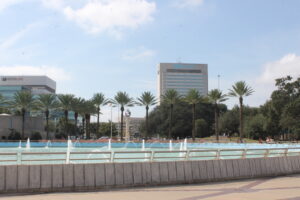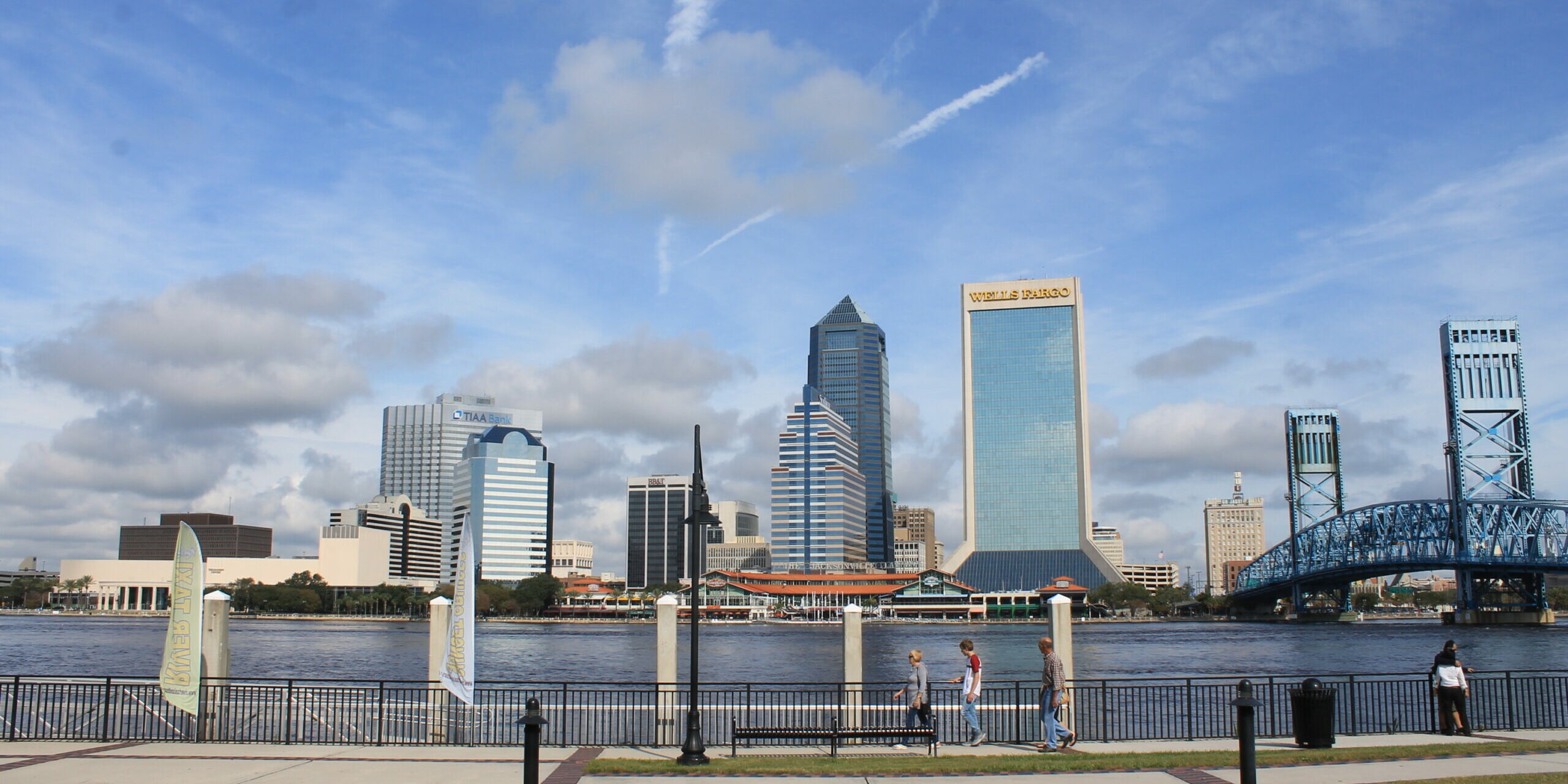Naval Air Station Jacksonville
About Naval Air Station Jacksonville
 Naval Air Station Jacksonville, or NAS Jax as colloquially known, is located eight miles south of the city’s central business district and is one of the Navy’s fastest-growing installations. It employs approximately 23,000 people and is considered Jacksonville’s largest employer. In combination with Naval Station Mayport,
Naval Air Station Jacksonville, or NAS Jax as colloquially known, is located eight miles south of the city’s central business district and is one of the Navy’s fastest-growing installations. It employs approximately 23,000 people and is considered Jacksonville’s largest employer. In combination with Naval Station Mayport,
United States Marine Corps Blount Island Command, and nearby Naval Submarine Base Kings Bay, NAS Jacksonville, is part of the third largest military presence in the United States and is the largest naval installation in the Southeast Region.
Here’s a fun fact: NAS Jacksonville was once home to the Blue Angels! Commissioned in 1940 primarily as a training and staging base for World War II, NAS Jacksonville housed 1,500 German prisoners of war and, in 1948, became the home for the Navy’s first jet carrier air groups and squadrons. As of 1949, the installation houses more naval aircraft than any place on the East Coast, from Nova Scotia to the Caribbean, accounting for over 60% of the Atlantic coast’s aircraft.
NAS Jacksonville is home to P-3C and C-130T aircraft. Patrol Squadron THIRTY (VP-30)—the Navy’s largest aviation squadron—is stationed here and is the first squadron to operate the new P-8 Poseidon aircraft. Currently, the installation’s primary mission is aviator training and anti-submarine warfare.
You can find Naval Hospital Jacksonville here as well. The hospital provides services to those stationed at NAS Jax and supports all medical programming for naval installations throughout the state.
NAS Jacksonville has a robust Fleet and Family Support Center with many programs available to all military personnel. One of their most popular transition programs is the monthly bus tour of Jacksonville offered to families moving to the area. In addition, a School Liaison Officer is available to assist in registering and placing military-dependent children in schools throughout the city. This holistic approach is part of why the installation received the 2012 Presidential Excellence Award and the 2013 Commander, Navy Installations Command Excellence Award.

About Jacksonville
Jacksonville is a sprawling metropolitan area that prides itself on being Florida's youngest, hippest part. In the First Coast region, on the Atlantic side of the state, and approximately 25 miles south of the Georgia border, Jacksonville is the largest city by land area in the contiguous United States. This unique feature allows more than 950,000 people to call this city home and what accounts for what locals call the "enormous amount of time it takes to get anywhere."
Jacksonville sits on the St. John's River, close to where it meets the Atlantic Ocean. It enjoys a humid, subtropical climate with average summer temperatures hovering around 92 degrees (°F) and winter temperatures averaging a balmy 64 degrees (°F). This climate has long made the area attractive to residents. The beginnings of the current city began back in 1564 when the French established the Fort Caroline settlement. In 1822, shortly after the U.S. acquired the territory, the modern-day town was founded and named after Andrew Jackson, Florida's first military governor and (more famously) our seventh president.
Due to its deepwater port and geographic location, Jacksonville has grown to an impressive stature over the years. It used to be the go-to winter resort area for the rich and famous. This designation may be why Jacksonville was once known as the "Winter Film Capital of the World." More than 30 silent films were made here during the early 20th century. In addition to being the place for those with money, Jacksonville has become a major banking and insurance center in recent years. This industry, along with the military, has become the backbone of the city's economic infrastructure and makes it one of the most stable city economies in the nation.
Jacksonville, or Jax to its residents, is an odd mix of history, culture, and modern amenities. Most of its historic architecture was lost in the Great Fire of 1901, after which the city was rebuilt by Midwest architects trained in the Prairie School of building design (think Frank Lloyd Wright). This accounts for the staggering collection of such buildings the city boasts today. In addition, Jax has a significant showing of mid-century modern architecture and some
of the state's first skyscrapers.
Jax is where the traditional Florida attitude of relaxation meets adventure. Adventure comes in the form of 22 miles of beaches replete with every outdoor activity you can think of…as long as it doesn't require snow! Jacksonville hosts many annual cultural experiences, including the Jacksonville Jazz Festival (the second largest in the U.S.), Springing the Blues Festival, and World of Nations Celebration. Not to be outdone by culture, the city is home to the NFL's Jacksonville Jaguars and several minor league sports teams from various organizations, including the Jacksonville Jumbo Shrimp AA baseball team. You almost have to go to a game because of the name alone! Or if museums and the arts are more your thing, Jax can give you incredible experiences.
Honestly, though, when people consider living in Florida, they often think of hurricanes and the kind of impact they can have. A hurricane has not directly hit Jacksonville since 1871. However, it has a history of being affected by hurricanes, including Hurricane Matthew in 2016 and Hurricane Irma in 2017, which produced record-breaking floods. So, if you're lucky enough to spend a few years here, concentrate on all this jewel of the First Coast has to offer! Residents will tell you that everything Jacksonville offers more than makes up for a few pesky hurricanes.
Looking at relocating?
Enter your information below and we will reach out to help the process.
Nearby Neighborhoods
St. John's Forest
One of the most popular neighborhoods to consider is St. Johns Forest. Located 23.6 miles southeast of NAS Jax, St. Johns is conveniently located next to both I-95 and I-295. This private, gated community is on the west side of the St. John’s River. It offers many award-winning amenities, including a clubhouse, swimming pool with beach entry, fitness center, and golf course. St. Johns Forest is situated between Jacksonville and St. Augustine, making it simple to access all these two cities have to offer. With an active Home Owners’ Association and easy access to both Northeast Regional Airport and Jacksonville International Airport, this community has larger homes at reasonable prices. Add in the consistently top-rated schools of St. Johns County, and this neighborhood is a natural consideration for families with children of all ages.
Big Plus
- Traveling to and from St. Johns Forest is simple, with easy access to interstates and two airports.
- The area is quite family-friendly and includes excellent schools.
- Home prices are reasonable, particularly considering the neighborhood location and amenities.
Things to Consider
- Commute time to NAS Jax is 30-40 minutes, without traffic incidents.
- Rentals go quickly, so working with an experienced real estate agent is of great help in this area!
- Drive time to Jacksonville/St. Augustine attractions may be significant.
Oakleaf Plantation
This community is the fastest-growing planned community in the nation. Its location 27 miles southwest of NAS Jacksonville may make some consider this neighborhood too far away. However, it is located on the same side of the river as NAS Jax, and the commute time is similar to that of St. Johns Forest. Oakleaf borders a state forest and boasts two planned village centers for shopping and dining and two state-of-the-art athletic centers. Schools are rated highly, and homes are priced similarly to St. Johns Forest. Oakleaf is proud of its championship golf course, so if golf is your thing, this may be the perfect spot for you! Woodfield Park, Arcadia Lakes, Heathwood, Cedar Lakes, Ashley Oaks, Cobblestone Park
Big Plus
- Recreation opportunities abound, with access to plenty of amenities and proximity to a state park.
- Easy access to interstates makes getting around more manageable.
- Oakleaf is considered to be quite family-friendly.
- Home prices are reasonable, particularly considering the area’s amenities.
Things to Consider
- Commute time to NAS Jax is 30-40 minutes, without traffic incidents.
- Rentals go quickly, so working with an experienced real estate agent is of great help in this area!
- Amenities may make you feel isolated from base installation.
Julington Creek Plantation
Located 18 miles south of NAS Jacksonville on the west side of the St. John’s River, Julington Creek Plantation is 15 miles from the Atlantic Ocean. This is an outdoors person’s paradise. With over 100 lakes, a nature preserve, and miles of biking and running trails, Julington Creek also boasts good schools and is desirably situated halfway between downtown Jacksonville and St. Augustine. While family-friendly, Julington Creek is not quite the insulated bubble of activity that can be found in planned communities like Oakleaf and St. Johns Forest. In addition, houses may be slightly smaller for what you pay, but are still reasonably priced.
Big Plus
- Getting outside is easy with proximity to tons of outdoor activities as well as the beach!
- Julington Creek Plantation is family-friendly, and residents have access to good schools.
Things to Consider
- Commute time to NAS Jax is 30 minutes, without traffic incidents.
- Housing prices are slightly higher here than in surrounding areas.
- Rentals go quickly, so working with an experienced real estate agent is of great help in this area!
- Other neighborhoods to consider that are extremely similar are Durbin Crossing and Bartram Springs. Bartram Springs is especially popular with young families.
Riverside/Avondale
If you’re looking for a more historic, more architecturally diverse, established neighborhood, look no further than Riverside and Avondale. Home to the Five Points area known for its cultural flair and active nightlife, Riverside and Avondale is located 7 miles north of NAS Jacksonville, making for an easy commute. These two interconnected neighborhoods are in Duval County. They therefore do not have consistently high-ranked schools, although their location right on the river, their cultural offerings, and their historic feel may make up for that.
Big Plus
- Commute is 15 minutes to NAS Jacksonville.
- Enjoy living in a historic cultural center right along the river.
- Both of these neighborhoods are established communities.
Things to Consider
- Schools in this area are not as highly rated.
- The houses in these neighborhoods are smaller and older.
- Real estate is diverse, and resale may not be as economically positive.
7 Reasons You Should Consider Buying a Home
1. TAX ADVANTAGES
To encourage homeownership, the IRS has provided many tax breaks for owning a home. Credits may be available for specific home improvements, such as using clean energy or for qualified first-time home buyers. The way most homeowners see those advantages is through income tax itemization and deductions like mortgage interest and real estate taxes.
2. STABALIZE MONTHLY HOME COSTS
Owning your own house is one of the safest bets on stabilizing your monthly home costs. There’s no worry of rent getting increased significantly after each year of living in someone else’s home. Additionally, when you answer to yourself, there is no worry of landlord changes or unexpected lease termination.
3. HOUSE HACKING
Generally speaking, house hacking is a smart strategy that involves renting out a portion of your primary residence as a means of generating income to offset your own living expenses. Think turning your finished basement or mother-in-law quarters into an AirBnB! Or consider purchasing a multi-unit duplex or triplex: live on one side and rent out the other! If your home making money while you’re living in it doesn’t sound like your thing, there’s always renting it out after you PCS as an income generating investment property.
4. Increased Privacy
Generally speaking, house hacking is a smart strategy that involves renting out a portion of your primary residence as a means of generating income to offset your own living expenses. Think turning your finished basement or mother-in-law quarters into an AirBnB! Or consider purchasing a multi-unit duplex or triplex: live on one side and rent out the other! If your home making money while you’re living in it doesn’t sound like your thing, there’s always renting it out after you PCS as an income generating investment property.
5. Pets Are Welcome!
For those who choose to rent instead of buying, it can be extremely difficult to find rentals who allow for your
four-legged, furry friends. Landlords often require hefty pet deposits or place heavy restrictions on the number of pets and breeds they allow—if they will even allow pets. When considering quality of life, including beloved pets and the indoor and outdoor space available to them matters. Having the flexibility to include ALL members of your family as a homeowner is priceless!
6. Pride of Ownership
One of the greatest benefits of owning your own home is the pride of ownership that comes along with it. Not only are homeowners more inclined to take good care of their investment with routine maintenance and cleaning, but also they are free to make design choices ranging from hanging artwork on the walls, to paint colors, to customization of closets, electronics, and more. As military families who relocate frequently, having your home reflect who you really are feels important.
7. Safe and Stable Long Term Investment + Forced Savings
Owning a home has historically been one of the safest, lowest risk financial investments that tends to have long-term stability and success. As your home value appreciates and your mortgage balance decreases, what’s left is growing equity with an eventual paid off home. Making a monthly house payment is akin to setting aside a specific amount each month into a savings account—it’s a little difficult to access in the moment, but over time it can build into something significant in the form of equity.

FIVE RESOURCES TO HELP YOU IN YOUR RELOCATION PROCESS

Your PCS is underway!
The home buying and moving transition process has begun. Now what? If it feels like there are a million things to do, don’t fret because you don’t have to do them all yourself. During the relocation process, there are many service providers that can assist you in making your move a smooth one.
Consider these five resources to help you in the process
1. MOVING COMPANIES
Sure, the military offers transportation and relocation services, but many service members decide to coordinate the transfer of household goods themselves. Not only can you often earn money on the difference between moving costs and weight allowances, but you can be assured that you have more control over your belongings. Services that moving companies offer can range from delivery of boxes and pods for the “you-pack” model all the way to full-service logistics companies that will do all of the packing, loading, driving, and unpacking for you.
2. STORAGE
Whether you need to store your household goods for a few weeks until you close on your home or you decide that you have more stuff than square footage, storage companies abound. Sizes, conditions, and contracts vary widely so be sure to do your homework before you commit. Particularly in climates with extreme cold, heat, or humidity, it is important to consider using only climate-controlled storage to ensure the protection of your furniture and temporarily unused items.
3. TEMPORARY HOUSING
It is not uncommon for there to be a short gap of time during a military move between when you arrive at your new duty station and your new home being available to inhabit. No longer are hotels the only option for sticking out a few days or weeks during the wait. Vacation Rentals by Owner (VRBO) and Airbnb are great options to make you feel more at home while you wait for your home. In fact, why not take advantage of seeing your new city through the eyes of a tourist? Find a location near new local attractions and dining and enjoy a few days of getting to know the lay of the land.
4. USPS/IRS
Once you get settled in at your new home, it’s important that you alert agencies that will make sure your current and up-to-date address is on file. The United States Postal Service (USPS) and the Internal Revenue Service (IRS) are two of the most important and by doing so, any important mail or documents in your name should be forwarded or sent along to your new address. It’s also a good idea to notify banks, credit card companies, and other debt collectors of a change of address. These days nearly all of these transactions can be handled online.
5. DISCARD & DONATE SERVICES
No matter how much you purge, toss, organize, minimize, or donate before you pack up the moving truck, it never fails that after you get unpacked on the other side there seems to be more stuff to declutter. Discard and donate services can help with this. Many are a phone call away and will happily come to your residence for a pickup. Others are structured where you simply drop off at a store. A lot of these services are charitable organizations and will offer you documentation for your own taxes based on your donation. It’s a win-win: you downsize by donating, and someone else benefits from your use of your items.

